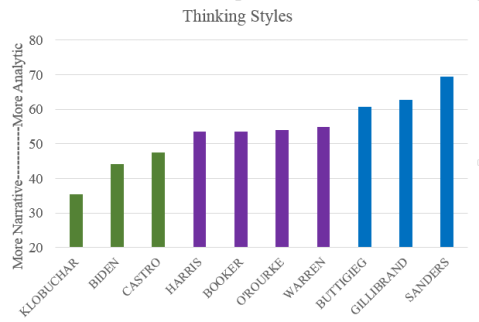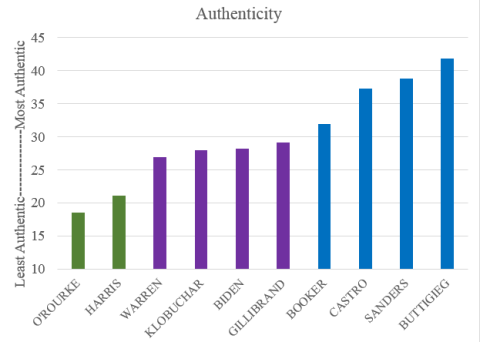Off to the Races: An Analysis of the First 2020 Democratic Primary Debates | Wordwatchers
Off to the Races: An Analysis of the First 2020 Democratic Primary Debates
June 28, 2019
Kayla N. Jordan
University of Texas at Austin
While candidates for the 2020 Democratic presidential nomination have already been campaigning for months, the primary season hit a new phase this week with the first debates between the candidates. Here, in the first of several blog posts about the 2020 election, I use computer-based text analysis methods to start to get a sense of the psychology of the candidates. Rather than their positions or policies, the goal of these posts will be to understand the candidates as people by considering questions like how are they thinking, how are they relating to other people, and how are they communicating their ideas.
The system the majority of the analyses will rely on is a program developed in the Pennebaker Lab at UT Austin called Linguistic Inquiry and Word Count, or LIWC2015 (available for academic research at liwc.net or for commercial application at Receptivit.com). LIWC can analyze any text to determine the percentage of words in the text indicative of negative emotion and cognitive processing and 80+ other dimensions. LIWC has been used in hundreds of studies in multiple disciplines ranging from psychology to business to medicine to political science to computer science. To learn more about some of these studies, check out this link.
So what can LIWC tell us about the 2020 presidential candidates? As the election season unfolds I will be looking at many dimensions including motivations, confidence, and time orientation, but for now I want to look at three central psychological dimensions: thinking style, emotional tone, and authenticity. Also, rather than cramming in all 20 candidates, I am going to focus on the ten candidates who, at the moment at least, seem to have the best chances of securing the nomination: Joe Biden, Bernie Sanders, Elizabeth Warren, Beto O’Rourke, Cory Booker, Kamala Harris, Julian Castro, Pete Buttigieg, Amy Klobuchar, and Kristen Gillibrand.
Thinking Style
People naturally differ in the ways that they think and communicate ideas. On one end of the spectrum, there are people who are very analytic, logical thinkers. Analytic thinkers organize their ideas in formal, hierarchical ways focusing on concepts and ideas. On the other end of the spectrum are people who think in narrative, intuitive ways. Narrative thinkers organize their ideas more informally, often telling stories and focusing on people and actions. Linguistically, analytic thinkers use more articles and prepositions while narrative thinkers use more pronouns, auxiliary verbs, adverbs, negations, and conjunctions. Check out this link or this link to learn more about the research on analytic thinking. So where do the Democratic candidates fall on this spectrum?
The Analytic Thinkers: Of the 10 candidates, 3 stand-out as the most analytic: Buttigieg, Gillibrand, and Sanders. These candidates talked about their policies and ideas in logical ways. They relied more on facts and figures focusing on concepts and details rather than stories and anecdotes. For example, take Bernie Sanders. When talking about his health care plans, he laid out the problem, gave statistics, and stated his proposals rarely making his positions personal.
The Narrative Thinkers: On the narrative end of the spectrum, Klobuchar, Biden, and Castro stand out. Unlike their analytic counterparts, they tell stories and anecdotes focusing on people and actions more than concepts and abstractions. Rather than making structured arguments, these candidates communicates their ideas in looser, more informal ways. Compare Biden’s discussion of health care to Sanders’. Where Sanders gave impersonal arguments, Biden connected his policy plans to his families’ personal experiences with cancer.
The In-Between Thinkers: Rather than falling on either end of the spectrum, four candidates fall somewhere in the middle: Harris, Booker, O’Rourke, and Warren. Drawing on both styles, these four candidates use both formal, logical structures as well as stories and personal experience. For example, when Elizabeth Warren talked about gun violence she used not only statistics and structured policy proposals but also anecdotes from her time on the campaign trail talking to voters.

Note. Analytic thinking scores are standardized composite scores ranging from 0 (most narrative) to 100 (most analytic).
Emotional Tone
Emotion has become a central feature of political campaigns and has been studied in a variety of ways such as fear appeals and negative advertising. Here, however, I focus on what the use of emotional language might say about a person’s general outlook. A more optimistic, upbeat outlook is indicated by positive emotional words such as love, respect, and happy. A more pessimistic outlook is indicated by the use of negative emotional words such as anger, death, and hurt. What were the candidates’ emotional outlooks in the first debates?
The Optimists: Three candidates were high in positivity: Gillibrand, Harris, and Klobuchar. These three women candidates all presented optimistic, upbeat messages. Gillibrand and Klobuchar, in particular, come across as affable during the debates occasionally mixing in humor and provide hopeful views of the future.
The Pessimists: Four candidates were on the negative side: Buttigieg, Sanders, Biden, and Booker. These candidates presented less positive images painting more pessimistic views of the future. Bernie Sanders was the clearest representation of negativity. For Sanders, there are many serious problems that must be addressed immediately and decisively to avoid a future filled with doom and gloom.
The Realists: The three remaining candidates fell in the middle: Warren, Castro, and O’Rourke. For these three candidates, their outlook is mixed with serious, urgent problems needing solutions, but with a hopeful outlook that such problems are solvable.

Note. Tone scores are standardized scores ranging from 0 (most negative) to 100 (most positive).
Authenticity
Politicians are often portrayed as less than honest, hence a final important dimension to consider is authenticity. Individual high on authenticity come across as honest and straightforward while those low on authenticity come across as evasive and impersonal. Linguistically, studies have found that authentic individuals tend to use more I-words, present-tense verbs, and relativity words (e.g. old, far, here) and fewer she-he words and discrepancy words (e.g. could, should). How authentic are the Democratic candidates?
The Most Authentic: The most authentic candidate was Pete Buttigieg closely followed Sanders and Castro with Booker is a somewhat distant fourth. In their debates, Buttigieg and Castro, in particular, came across open and personal giving straightforward, clear answers to questions. Warren, Klobuchar, Biden, and Gillibrand fall in the middle of pack, but were slightly closer to the authentic candidates than to the inauthentic candidates. These four generally came across as straight-forward and personal but with moments of distance and evasion.
The Least Authentic: The least authentic candidate was Beto O’Rourke with Kamala Harris in a close second. O’Rourke was particularly striking in the debates. Despite the large amount of attention he received in his 2018 Senate Run, O’Rourke during the first debate came across as distant and impersonal often giving responses seeming robotic and rehearsed.

Note. Authenticity scores are composite standardized scores ranging from 0 (least authentic) to 100 (most authentic). In political contexts, the range is generally limited with scores effectively ranging from 0 to 50.
Going Forward
These are just a few initial insights into the 2020 Democratic candidates, and as we gather more data throughout the primary season, we will gradually gain a clearer sense of who these candidates are and how they might behave as leaders. That said, there is one broad takeaway from this first look at the 2020 candidates. While many of the candidates have similar (or even identical) policy positions, the analysis presented here shows the candidates have very different personalities and communication styles. The ideological similarities between candidates in a primary election can make choosing between them difficult, and I hope that the psychological views on the candidates that I will be presenting in these blog posts can provide additional information for voters who want another perspective of the candidates.
Check back later for further insights of the 2020 Democratic presidential candidates as I analyze the debates and other (linguistically) interesting campaign events this election cycle. For more information on this project, contact Kayla Jordan (kaylajordan@utexas.edu). For more information about LIWC, check out this link.